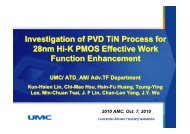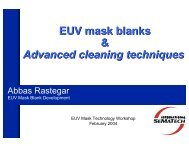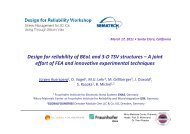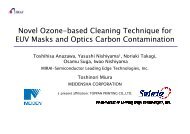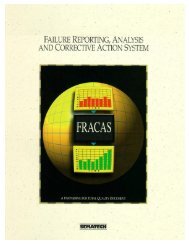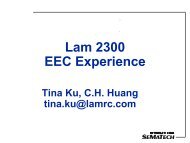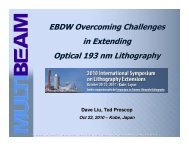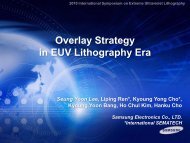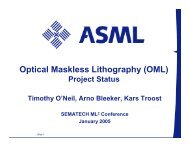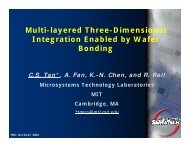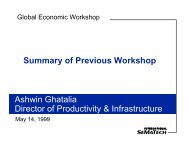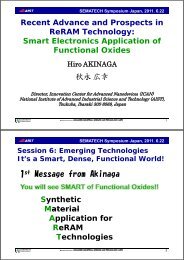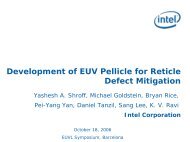EUV Resist Materials Properties and Performance - Sematech
EUV Resist Materials Properties and Performance - Sematech
EUV Resist Materials Properties and Performance - Sematech
You also want an ePaper? Increase the reach of your titles
YUMPU automatically turns print PDFs into web optimized ePapers that Google loves.
<strong>EUV</strong> <strong>Resist</strong> <strong>Materials</strong><br />
<strong>Properties</strong> <strong>and</strong> <strong>Performance</strong><br />
Michael Leeson 1 , Heidi Cao 1 , Wang Yueh 1<br />
Robert Meagley 1 , Geeta Sharma 2 , Shalini Sharma 2<br />
Intel 1 , LBNL 2
2<br />
Long Term <strong>EUV</strong> <strong>Resist</strong> Targets<br />
Patterning for the 22nm node & Beyond (HVM 2011+)<br />
Tri-ability: Availability, Affordability & Profitability<br />
Resolution : Meet the Design Rules<br />
(updates with generation as device designs are finalized)<br />
LWR (3σ) :
3<br />
Shorter Term <strong>Resist</strong> Phase Goals to<br />
Support Pre-Insertion Tests<br />
In addition to meeting the long term goals, resists<br />
will also be needed for nearer term experiments.<br />
Example of<br />
approximate<br />
timing <strong>and</strong> goals<br />
Time CD Pitch LWR Dose<br />
Q1'07 60nm (trench) 150nm
4<br />
A Selection of Recent <strong>EUV</strong> resist patterning<br />
results from Intel MET<br />
Min Resolution for<br />
60nm 1:1<br />
Supplier <strong>Resist</strong> Name 1:1 Structures (nm) CD DOF (+/-2%) (nm) Photospeed (mJ/cm2) LWR (nm)<br />
A <strong>Resist</strong> 1 50 140 5.4 13.9<br />
A <strong>Resist</strong> 2 40 280 11 6.6<br />
A <strong>Resist</strong> 3 36 160 9.5 7.9<br />
A <strong>Resist</strong> 4 38 120 10 5.5<br />
A <strong>Resist</strong> 5 38 120 11.5 5.6<br />
B <strong>Resist</strong> 6 50 175 5.5 11.3<br />
B <strong>Resist</strong> 7 48 80 5.2 13.2<br />
B <strong>Resist</strong> 8 38 180 5.5 9.2<br />
B <strong>Resist</strong> 9 40 200 7 8.2<br />
C <strong>Resist</strong> 10 45 350* 11.5 8.4<br />
C <strong>Resist</strong> 11 40 350* 11.1 7.8<br />
C <strong>Resist</strong> 12 45 300 15 7.7<br />
C <strong>Resist</strong> 13 36 210* 15.5 6.7<br />
D <strong>Resist</strong> 14 45 210 10.5 7.4<br />
D <strong>Resist</strong> 15 55 280 10 11.3<br />
D <strong>Resist</strong> 16 36 300 17.5 4.2
60 nm L/S<br />
6.6 nm LWR<br />
11 mJ/cm 2 sensitivity<br />
5<br />
<strong>Resist</strong> Screening Example<br />
Conventional LAER Formulated for <strong>EUV</strong><br />
46 nm L/S<br />
14 mJ/cm 2 sensitivity<br />
36 nm L/S<br />
14 mJ/cm 2 sensitivity
Focus<br />
6<br />
Dose<br />
Process Window<br />
60nm 1:1, 50nm focus steps, 1.5mJ dose steps
7<br />
<strong>Resist</strong> Screening Example – CAR + New Additive<br />
50 nm L/S<br />
4.2 nm LWR<br />
17.5 mJ/cm 2 sensitivity<br />
40 nm L/S<br />
6.1 nm LWR<br />
18 mJ/cm 2 sensitivity<br />
30 nm CD, 90 nm pitch<br />
14 mJ/cm 2 sensitivity
8<br />
<strong>Resist</strong> Screening Example – New material<br />
Dose to Print ≈ 11mJ<br />
50nm 1:1<br />
LWR ≈ 5 nm<br />
40nm 1:2<br />
LWR ≈ 5 nm<br />
40nm 1:1<br />
Not Resolved<br />
30nm 1:3<br />
LWR ≈ 5 nm
<strong>Resist</strong> Screening Example – new material / mechanism<br />
CD 50 nm<br />
LWR 4 nm<br />
CD 40 nm<br />
LWR 4 nm<br />
CD 40 nm<br />
LWR 6 nm<br />
CD 35 nm<br />
LWR 4 nm<br />
Initial results for this resist show promising LWR <strong>and</strong> good<br />
9<br />
resolution but photospeed of ≈ 35mJ needs improvement.<br />
CD 32 nm<br />
LWR 6 nm<br />
CD 30 nm<br />
LWR 6 nm
10<br />
LWR Complexity<br />
LWR is a multi-factorial phenomenon that can arise from a<br />
number of separate causes.<br />
Possible source of LWR:<br />
• Phase separation between protected <strong>and</strong> de-protected polymer<br />
• Polymer inhomogeneity, colloid redeposition, <strong>and</strong> Mw/Pd<br />
• PAG density <strong>and</strong> PAG/base ratio effects<br />
• Polymer ‘grain’ size<br />
Intel confirmed<br />
• Photospeed: the slower the resist, the lower LWR<br />
• Aerial image: the better the NILS, the lower LWR<br />
• Tool NA: the higher NA, the lower LWR<br />
• Acid diffusivity: the higher diffusivity, the lower LWR<br />
• LWR has a strong impact on several device performance<br />
parameters<br />
Further work is needed to characterize effects on device<br />
performance by layer, as a function of frequency <strong>and</strong> through<br />
correlation of litho <strong>and</strong> etched LWR
11<br />
Collaborations<br />
Making progress towards our goals through fundamental underst<strong>and</strong>ing,<br />
new materials, metrology, process <strong>and</strong> equipment research<br />
New <strong>Resist</strong> <strong>Materials</strong><br />
• Molecular Glasses – Both new materials <strong>and</strong> low Mw analogues of existing platforms<br />
• Inorganic resists - Photosensitive thin, dense, pore free, <strong>EUV</strong> sensitive films<br />
• Chain Scission – Both CAR <strong>and</strong> non-CAR materials, QSPR screening, radical trap materials<br />
• New PAGs – Non-PHOS <strong>and</strong> polymer-bound PAG (anion <strong>and</strong> cation) development<br />
• <strong>Resist</strong> Suppliers – Screening <strong>and</strong> component development with suppliers <strong>and</strong> sub-suppliers<br />
Process / Equipment Development<br />
• Smoothing – LWR reduction through post develop processing (chemical, thermal, photo, etc.)<br />
• SCCO2 Developer - Reduced line collapse for high aspect ratios features, plus LWR reduction<br />
• <strong>EUV</strong> IL Tool –Equipment for resist research <strong>and</strong> screening<br />
• CDSAXS – <strong>Resist</strong> LWR <strong>and</strong> cross section profile using small angle x-ray scattering<br />
• Outgassing – Measurement & characterization of resist outgassing under <strong>EUV</strong><br />
<strong>Resist</strong> Fundamentals<br />
• <strong>EUV</strong> Photochemistry – Modeling reaction mechanisms in <strong>EUV</strong> <strong>and</strong> e-beam resists<br />
• LWR Fundamentals – Measuring the extent of CAR deprotection <strong>and</strong> PAG concentration<br />
• <strong>Resist</strong> Simulations – Molecular resists, LWR characterization <strong>and</strong> simulation<br />
• Material LWR – Underst<strong>and</strong>ing the material sources of LWR<br />
• CFM – Mapping surface chemical distributions
12<br />
<strong>Resist</strong> Morphology<br />
Photoresist is a mixture of large (5nm) & small (0.5 nm) molecules<br />
Aggregation <strong>and</strong> gradients emerge as meso-scale anisotropy in the<br />
resist<br />
1000nm<br />
Anisotropy results from molecular forces interacting<br />
500nm
13<br />
Harnessing Molecular Anisotropy<br />
Engineering molecular functionality is “preorganization” (Cram, Nobel-‘87)<br />
Chemicals systems with emergent, long-range structure are “self<br />
assembling”<br />
Intel’s Molecules for Advanced Patterning Program (MAPP) designs<br />
preorganization & self assembly into lithographic materials<br />
Chaotic Uniform<br />
“Sub 30nm photoresist design” Future fab International, Issue 26,<br />
June 2006 http://www.future-fab.com/documents.asp?d_ID=4005
14<br />
MAPP Prototypes Overview<br />
Class Types Result<br />
APPAG<br />
Advanced Developer<br />
Scissionable<br />
Steroidal Dendrimer<br />
Scissionable<br />
Quencher Backbone<br />
Long & Short<br />
Diffusion helps DOF<br />
& profile<br />
Varied nonionic <strong>and</strong><br />
ionic additives<br />
Scissionable Host<br />
for PAG Guest<br />
6 kinds of G0 made<br />
G1 made in June<br />
Preorganized<br />
quencher directs<br />
acid to protection<br />
6 copolymers<br />
Improved DOF & profile of<br />
footed process; undercut<br />
with square profile<br />
process<br />
Enables improved<br />
photospeed, margin, <strong>and</strong><br />
diffusion<br />
G0
15<br />
Fate of Light in <strong>Resist</strong><br />
Catalyst precursor absorbs light making acid pattern<br />
Other resist components absorb light too (thermal noise)<br />
Light is pattern information, so…<br />
… more information (acid) is presented on top…<br />
… <strong>and</strong> catalyst precursor can only make less acid on bottom.<br />
Lithography process <strong>and</strong> materials are challenged to compensate<br />
Some substrates also deplete acid (SiN, SiON)<br />
Feet didn’t dissolve!
16<br />
Preorganized interfaces<br />
HMDS tunes wafer surface energy to match resist surface energy<br />
This adhesion promoter glues resist to wafer in current processes<br />
Can a light sensitive adhesion promoter boost interfacial contrast?<br />
APPAG6<br />
Feet<br />
dissolved!<br />
“Smart Interfaces: improving pattern fidelity with the gain enhancing<br />
underlayers, APPAG”, J. Macromolecular Sci., 45(6), 2006
17<br />
300<br />
238<br />
CD, nm<br />
175<br />
115<br />
50<br />
APPAG DUV <strong>and</strong> <strong>EUV</strong><br />
DUV (1/4 μ) experiment shows depth of focus improvement<br />
<strong>EUV</strong> experiment shows lower PEB enabled for process<br />
APPAG tunes substrate surface pH <strong>and</strong> hydrophobicity<br />
Other functional groups <strong>and</strong> ion pairs under study<br />
APPAG6<br />
APPAG9<br />
Control<br />
BARC<br />
248 nm<br />
defocus 0 μ<br />
-1.5 -0.9 -0.26 +0.38 +1<br />
Defocus, μ<br />
175<br />
150<br />
125<br />
100<br />
75<br />
5200<br />
<strong>EUV</strong>: 11, 10, 9 & 8mj/cm**2<br />
80 degree PEB<br />
HMDS<br />
APPAG6<br />
5300<br />
5400<br />
Focus, Å<br />
5500<br />
5600
18<br />
Alternative developers<br />
Developer additives found that smooth features<br />
Photospeed accelerating additives noted too<br />
For investigation:<br />
• Additives (size, shape, functionality)<br />
• Ions (concentration, activity & size)<br />
<strong>EUV</strong> 45nm<br />
(30nm semi-dense<br />
mask)
19<br />
Scissionable Steroid Dendrimer<br />
PAG preorganized by branches<br />
Branches are cut then ionized by PAG<br />
G0 shows E0 of 5mJ/cm**2<br />
G0<br />
G0<br />
G1<br />
e-beam
20<br />
Scissionable Bound Quencher<br />
Preorganized base steers protons<br />
Main chain is cut proximal to base<br />
Lower Tg restricts PEB & limits resolution<br />
700 nm CD<br />
e-beam<br />
Flexible linker<br />
<strong>EUV</strong> Dose mJ/cm 2
• Rings raise glass<br />
transition 2 ways<br />
• Rigid <strong>and</strong> bulky<br />
21<br />
Conformational restriction<br />
• Scale-up underway<br />
Larger “R group” has smaller<br />
vibrational cone (pinacol, ring)<br />
C<br />
H 3<br />
C<br />
H 3<br />
O<br />
O<br />
O<br />
O<br />
N<br />
N<br />
O<br />
O<br />
O<br />
O<br />
C<br />
H 3<br />
CH 3<br />
N<br />
CH3 H 3C<br />
CH 3<br />
O<br />
CH 3<br />
H<br />
OH
22<br />
Summary<br />
• <strong>Resist</strong> screening continues on Intel MET <strong>and</strong> other available<br />
tools with c<strong>and</strong>idates for intermediate patterning goals<br />
starting to appear.<br />
• Resolution continues to show improvement on the Intel MET.<br />
- specifically sub-30 nm iso lines; 35nm L/S <strong>and</strong> 40nm holes.<br />
• LWR is challenging <strong>and</strong> a predictor of transistor performance.<br />
Intermediate patterning targets may be achievable with<br />
conventional materials, but new concepts may be required to<br />
meet long term needs.<br />
• Several university / material supplier <strong>and</strong> internal programs<br />
are extending our knowledge <strong>and</strong> providing interesting<br />
materials designed to help us meet our goals.<br />
• New prototype materials controlling molecular behavior,<br />
interfacial chemistry <strong>and</strong> film organization show new<br />
performance opportunities.
23<br />
Acknowledgements<br />
<strong>Resist</strong> / Material suppliers<br />
University Collaborators<br />
<strong>Sematech</strong> / IMEC / NIST / National Labs*<br />
Intel Components Research <strong>EUV</strong> Litho Team<br />
* DE-AC02-05CH11231



